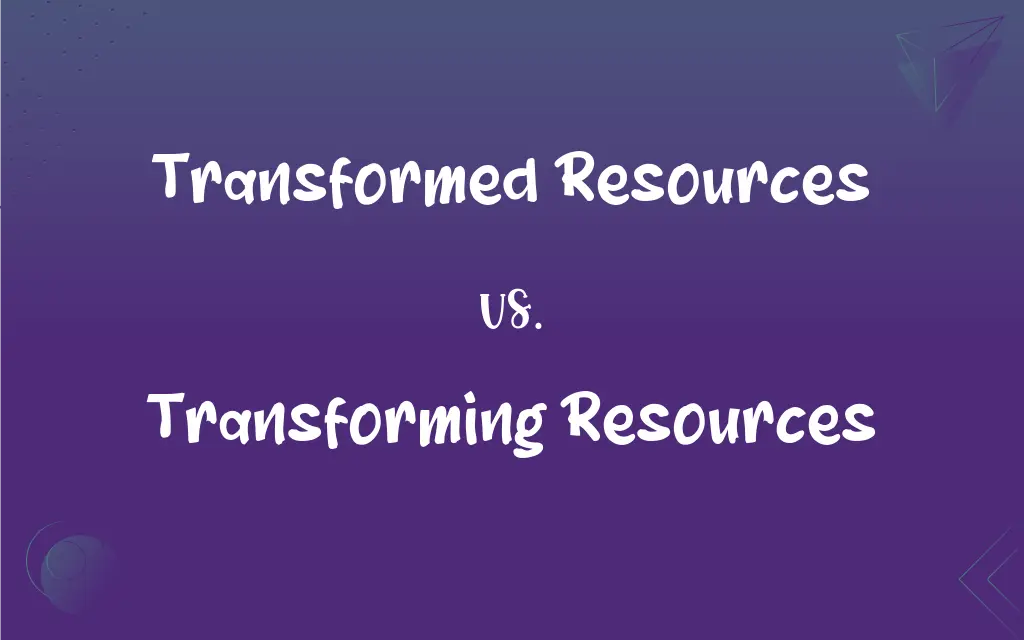Transformed Resources vs. Transforming Resources: What's the Difference?
Edited by Aimie Carlson || By Janet White || Published on March 17, 2024
Transformed resources are materials, information, or customers altered in production; transforming resources are facilities and staff that perform the transformation.

Key Differences
Transformed resources and transforming resources are fundamental concepts in operations management, distinguishing between the inputs that are processed and the agents of that processing within a production system. Transformed resources refer to those inputs that undergo some form of transformation to become outputs. These resources can include raw materials, information, and customers themselves, each subject to the operations process to produce goods or services. Transforming resources, on the other hand, are those elements within the production process that act upon the transformed resources. These include the human resources (staff, workers, managers) and the physical resources (machinery, buildings, equipment) that participate directly in transforming inputs into finished goods or services.
The distinction between transformed and transforming resources highlights the dual role of inputs in production processes. Transformed resources are passive participants, subjected to the operations process to emerge as outputs. Transforming resources are active agents, applying their capabilities, skills, and technologies to effect the transformation. This distinction is crucial for understanding how value is added in production and how operational efficiency can be optimized by managing both types of resources effectively.
Transformed resources are the materials, data, or customers that are changed in form, utility, or condition, transforming resources are the capabilities and assets employed to make those changes happen. This conceptual framework helps businesses and operations managers to systematically categorize and analyze the components of their production processes, facilitating better planning, control, and improvement of operations.
The interplay between transformed and transforming resources is at the heart of operations management. Understanding and optimizing the use of both types of resources is essential for achieving operational effectiveness, enhancing product or service quality, and ensuring customer satisfaction. This dynamic underscores the importance of strategic resource management in creating value within any production system.
Comparison Chart
Nature
Passive inputs that are processed
Active agents that perform processing
ADVERTISEMENT
Examples
Raw materials, information, customers
Employees, machinery, facilities
Role in Production
Undergo transformation
Facilitate transformation
Value Addition
Value added through change in form, utility, or condition
Value added by enabling the transformation process
Optimization Focus
Quality, suitability, and preparation of inputs
Efficiency, effectiveness, and capability of processing
Transformed Resources and Transforming Resources Definitions
Transformed Resources
Customers receiving services in a process.
Patients are diagnosed and treated in a healthcare facility.
ADVERTISEMENT
Transforming Resources
Staff and machinery that transform inputs into outputs.
Engineers and CAD software are used to design new products.
Transformed Resources
Materials processed in a manufacturing system.
Grains are milled and baked into bread in a bakery.
Transforming Resources
Facilities and workers involved in service delivery.
Teachers and classrooms facilitate learning in schools.
Transformed Resources
Information that is compiled and analyzed to create reports.
Market data is analyzed to generate investment strategies.
Transforming Resources
Human and physical assets used in production processes.
Chefs and kitchen equipment are utilized to prepare meals in a restaurant.
Transformed Resources
Entities that gain value through changes in state or condition.
Raw wool is spun and dyed to become yarn for textiles.
Transforming Resources
Resources that apply skills and technology in operations.
Programmers and computers develop software applications.
Transformed Resources
Inputs that are altered to produce goods or services.
Steel is heated and shaped into car frames in an automotive plant.
Transforming Resources
Agents that enable the transformation of materials or information.
Logistics companies and their fleets deliver goods worldwide.
FAQs
What are transforming resources?
The staff and facilities that perform the transformation of inputs.
How do transformed resources add value?
Through changes in form, utility, or condition that enhance their value.
Can a resource be both transformed and transforming?
Typically, resources are categorized as one or the other based on their role in the production process.
What role do transforming resources play in production?
They apply capabilities and technologies to effect transformation.
What are transformed resources?
Inputs that are changed or processed in production to become outputs.
What challenges are faced with transforming resources?
Staff training needs, equipment maintenance, and technology updates.
Why are transformed resources important?
They are the raw materials, information, or customers that are the reason for and result of production processes.
What is an example of a transformed resource in a restaurant?
Ingredients that are cooked and presented as dishes.
Can technology be considered a transforming resource?
Yes, when it directly contributes to the transformation process.
What is an example of a transforming resource in healthcare?
Medical staff and equipment used to diagnose and treat patients.
How are transforming resources managed?
By developing skills, ensuring operational efficiency, and maintaining equipment.
What challenges exist in managing transformed resources?
Variability in quality, supply chain issues, and preparation needs.
What impact do transforming resources have on product quality?
Direct impact through their skill, precision, and ability to utilize inputs effectively.
In what ways can transformed resources influence production capacity?
The availability and quality of transformed resources can limit or expand what can be produced.
Are digital assets considered transformed or transforming resources?
Digital assets can be both, depending on their use; as data for analysis (transformed) or tools for production (transforming).
How can transforming resources be optimized?
Through training, maintenance, and technological upgrades to improve efficiency and effectiveness.
How does innovation affect transforming resources?
Innovation can improve the efficiency and capabilities of transforming resources, enhancing production processes.
How do service industries utilize transformed resources?
Customers are often the transformed resources, receiving and benefiting from the service.
How do businesses manage transformed resources?
By ensuring quality, availability, and appropriate preparation for processing.
How do operations managers balance these resources?
By aligning the capacities and capabilities of transforming resources with the needs of transformed resources.
About Author
Written by
Janet WhiteJanet White has been an esteemed writer and blogger for Difference Wiki. Holding a Master's degree in Science and Medical Journalism from the prestigious Boston University, she has consistently demonstrated her expertise and passion for her field. When she's not immersed in her work, Janet relishes her time exercising, delving into a good book, and cherishing moments with friends and family.
Edited by
Aimie CarlsonAimie Carlson, holding a master's degree in English literature, is a fervent English language enthusiast. She lends her writing talents to Difference Wiki, a prominent website that specializes in comparisons, offering readers insightful analyses that both captivate and inform.
































































